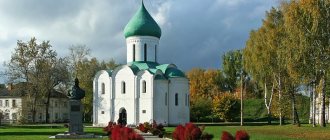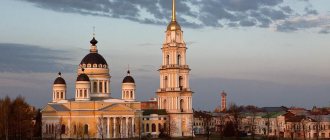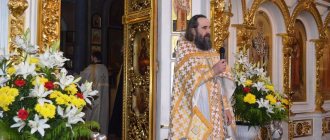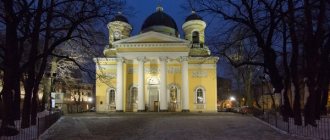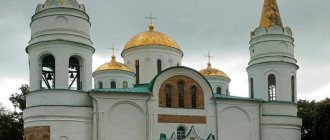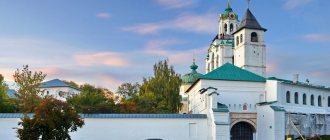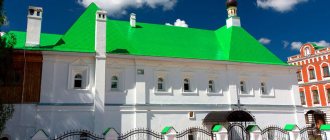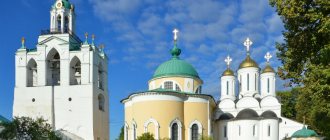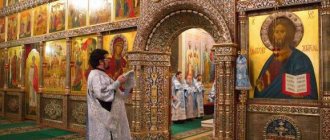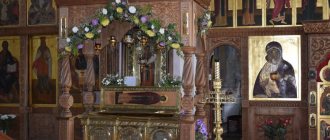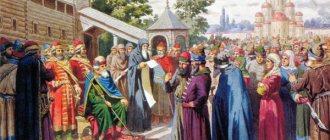"Save me, God!".
Thank you for visiting our website, before you start studying the information, please subscribe to our Orthodox community on Instagram, Lord, Save and Preserve † - https://www.instagram.com/spasi.gospodi/. The community has more than 60,000 subscribers. There are many of us like-minded people and we are growing quickly, we post prayers, sayings of saints, prayer requests, and timely post useful information about holidays and Orthodox events... Subscribe. Guardian Angel to you!
Sormovsky Transfiguration Cathedral in Nizhny Novgorod is a true decoration of the city and a unique historical landmark. The building with silver domes, white columns and cornices produces powerful and at the same time graceful beauty. Of the hundred years of its existence, the cathedral was not active for more than sixty. The parishioners’ “kopecks” helped bring him back to life, just like before. Now in the mornings the most beautiful church bells can be heard on the streets of Sormovo.
History of the temple
Nowadays, Sormovsky district is part of the city. And in the 19th century, the small village of Sormovo was located on the outskirts of Nizhny Novgorod. Intensive development here began in the middle of the 19th century, when disparate workshops merged into a single production - the “Machine Factory for Towing and Import Shipping.” Time passed, and it grew into a real industrial center - the Sormovo shipbuilding plant. More than 10.5 thousand people worked at its production facilities, and Nizhny Novgorod had the opportunity to grow, largely thanks to this enterprise.
Spaso-Preobrazhensky Cathedral from a bird's eye view
With donations from workers from factory villages, a church was first erected in honor of the holy noble prince Alexander Nevsky. Its construction did not take long and was completed in December 1882. However, the small temple, especially on weekends and holidays, was not able to accommodate everyone who came for prayer. It is for this reason that six years later the trustees of the parochial schools belonging to the shipbuilding industry decided to build a new church in Sormovo and dedicate it to the Christian holiday of the Transfiguration. To resolve all administrative issues and collect donations, a special construction committee was created, the famous Russian industrialist and engineer Fyodor Foss was elected chairman, and Nizhny Novgorod Bishop Vladimir blessed the construction.
The new cathedral was also erected at the expense of Sormovo workers. And among local residents this temple was called “penny” for a long time, since they allocated one penny from every ruble of their salary for construction.
General view of the Transfiguration Cathedral
The new cathedral required more than 2.5 million bricks. And eleven bells for the temple belfry were cast by Yaroslavl craftsmen. In order not to reduce the quality of the stonework, the cathedral was built only when it was warm - during three summer seasons, and construction was suspended in winter.
The large Sormovo Cathedral could accommodate about 2,000 parishioners at a time. The interior decoration was completed in 1903, and two years later, the consecration of the main cathedral altar took place. Inside the cathedral they placed a huge six-tiered wooden and gilded iconostasis with a beautiful forged cross on top. Soleia steps made of marble led to the altar from the spacious hall for worshipers. The temple was very beautiful, and in 1903 its appearance and rich interiors were captured in photographs by the famous Nizhny Novgorod photographer Maxim Petrovich Dmitriev.
After the revolution of 1917, with the new government in the country, a different attitude towards the church came. In 1927, by decision of the Nizhny Novgorod provincial executive committee, the wooden belfry was destroyed and its bells were confiscated. They removed all the metal roofing from the cathedral and intended to blow it up. However, then the city authorities decided to turn the iconic building into the Palace of Labor. But there were not enough funds to implement these plans, so in 1934, a House of Culture for children was first located in the former church, and then the premises began to be used as warehouses for medicines and food. The vaulted sub-church was ugly partitioned off and a refrigerator was made inside for storing fish.
For the next fifty years, no one cared about the temple, and it became very dilapidated. A huge cathedral stood in the center of Sormovo, like a silent reproach to the authorities. Restoration work on the temple was carried out for the first time only in 1987.
Three years later, the Sormovo Cathedral was returned to the believers, and its new birth began. Money for repairs and restoration of interiors was collected as many years ago - for a penny. Many Nizhny Novgorod residents donated icons kept in their families to the temple and voluntarily worked at the construction site. The restoration of the iconostases was carried out by specialists using old photographs and archival drawings. In parallel with the restoration of the cathedral, parishioners and builders landscaped the temple area, erected a fence and repaired the parable house, in which they equipped the premises of a refectory, baptism and Sunday school. The first church service in the Sormovo Cathedral was held in 1991 - during the celebration of Easter. And by its centenary (2005), the temple was already completely restored.
Muslim mosques
Islam in Nizhny Novgorod is widely developed and represented by an organization of religious significance - the Spiritual Administration of Muslims of the Nizhny Novgorod Region and, perhaps, in terms of its prevalence in the city, it ranks second after Orthodoxy. Under the auspices of the Spiritual Administration there are:
- Nizhny Novgorod Islamic Institute;
- secondary educational institution;
- youth movement;
- Sunday School;
- Publishing House;
- and, of course, mosques.
Nizhny Novgorod Cathedral Mosque
A significant leading spiritual place for all Muslims of Nizhny Novgorod and the Nizhny Novgorod region is located almost in the very center of the city, on Sennaya Square. The opening of the mosque took place in 1915 and, like most religious sites in Nizhny Novgorod, in the middle of the 20th century it underwent some difficulties: the building began to be used for military purposes, but already in 1988 the mosque again belonged to Muslims. You can learn more about the rules of conduct in the mosque and other interesting information regarding Islam on the official website.
Address: Nizhny Novgorod district, Kazanskaya Embankment, 6. The nearest stop is Sennaya Square.
Tawba Mosque
The Tauba Mosque was opened relatively recently in 2001 and is located in a quiet residential neighborhood in the lower part of the city.
Address: Avtozavodsky district, Melnikova street, 7. The nearest stop is “Gazovskaya”.
Nizhny Novgorod Cathedral Mosque named after Mufti Abdulvahid Soleimani
A small mosque located in the Krasnaya Etna microdistrict of the Leninsky district. The number of parishioners at Friday prayers does not exceed 100 people, and on weekdays - even five.
Address: Leninsky district, Izhevskaya st., 42a. The nearest tram stop is “Rostovskaya”, the bus stop is “Donbasskaya”.
Architectural features of the cathedral
The design of the cross-domed cathedral was developed by city architect Pavel Petrovich Malinovsky. In 1903, he moved to work in Moscow, so the architect V.A. had to complete the construction of the cathedral. Kosov, one of the designers of the Cathedral of Christ the Savior in Moscow.
The cathedral in Sormovo was built in the traditions of a pseudo-Byzantine style, rare for Russia, with eclectic elements. There are only three similar churches in our country - in New Athos, St. Petersburg and Volgograd. Art historians believe that the prototype of the Sormovo temple was the St. Sophia Cathedral, dedicated to Alexander Nevsky.
The temple bell tower is located below the main dome. This violation of generally accepted canons was done intentionally to emphasize the elevated position of the central part of the cathedral and the aspiration of the entire structure to the sky. The vaults of the dome are made according to the latest construction technologies of the beginning of the last century - using reinforced concrete structures.
Today, the tall and massive temple is visible from afar. It has a width of 29.9 m, and with the bell tower, the width reaches 46.9 m. The main dome rises to the cross to the height of a 12-story building (42.7 m). There are few churches of this size in the city. The temple has silver domes, which look very beautiful in combination with red brick walls, snow-white half-columns and cornices.
Architecture
There are three similar neo-Byzantine style cathedrals in Russia: New Athos, St. Petersburg and Volgograd. The prototype of the structure is the Alexander Nevsky Temple in Sofia, Bulgaria.
The building is decorated with a large and beautiful dome, around it there are semi-domes in the four cardinal directions. The façade is decorated with double white pilasters between the windows. The projections are decorated in white, the window glass is bluish and organically combines with the gray color of the domes.
The interior is imaginary with its decoration. The columns, walls and floor are decorated with white artificial marble. When entering the cathedral, the impression of purity and innocence is created. Photographer Dmitriev captured the first view of the structure and left it for the future generation.
Current state of the cathedral and visiting hours
Sormovo Cathedral is a functioning Orthodox church. Its central altar is dedicated to the Transfiguration of the Lord. In addition, there are chapels of the icon of the Kazan Mother of God and the prophet Elijah.
Fragment of the facade of the Transfiguration Cathedral
Church services are held on weekdays at 7.00 and 17.00, and on Sundays and holidays at 6.00 and 16.00. In the mornings, the streets of the Sormovsky district are filled with beautiful church bells.
There is a Sunday school at the cathedral, created for the children of parishioners, and on Tuesdays from 17.00 to 20.00 the Orthodox lecture hall is open for believers.
Patronal feasts are celebrated here on July 21, August 2 and 19, and November 4.
Domes of the Transfiguration Cathedral
1. Spaso - Transfiguration Cathedral
Sormovo Transfiguration Cathedral is rightfully considered one of the most beautiful churches in the Nizhny Novgorod region. Built according to the design of the famous Nizhny Novgorod architect Pavel Malinovsky in 1905, it differs from other city churches in its amazing architecture. Only three such churches in the neo-Byzantine style were built in Russia. The cathedral was built with money deducted from the salary of each worker in the amount of 1 kopeck for every ruble, which is why it was popularly nicknamed “Kopechny”. Thanks to its interesting history, inseparable from the history of the area, the cathedral is the calling card of Sormovo and the main temple of the deanery. Currently, the Sormovo Transfiguration Cathedral is a major spiritual and educational center in Nizhny Novgorod. Divine services are held daily in the temple, regularly dozens of little Sormovites receive Baptism, and young couples receive a blessing for life together in the sacrament of Wedding. Today the Sunday school at the Transfiguration Cathedral has 103 students. It is here that children receive ideas about the Orthodox faith and Christian hope, make pilgrimage trips to Nizhny Novgorod and Russian shrines, and become familiar with Orthodox culture. From 2003 to 2014 The parish newspaper “Orthodox Interlocutor” was published. The monthly publication talked about Orthodox holidays, Christian traditions and significant events in parish life.
Daily services:
Hours and Liturgy - 8.30. Vespers and Matins at 17.00.
Prayer services:
Before the revered icons of the Most Holy Theotokos: “Helper in childbirth” - weekly, on Thursday, at 13.00. “The Inexhaustible Chalice” - weekly, on Wednesday, after the evening service.
Address: 603003, Nizhny Novgorod, st. Shcherbakova, 15a. Telephone:
Nearest public transport stops:
“Sormova Center” (~370m), “R. Alekseev Square” (321m), “Ulitsa Kultury” (~482m) Nearest metro station: “Burevestnik” (2408m)
Story
"Penny Temple"
In the 19th century, the handicraft workshops of the Kama-Volga Shipping Company near the village of Sormovo, Balakhninsky district, united into the “Machine Factory for Towing and Import Shipping.” By 1849, the factory had turned into a huge enterprise of Russian industry - the Sormovo shipbuilding plant. By the end of the 19th century, 10,748 people worked there. The old factory Alexander Nevsky Church could no longer accommodate all its parishioners, especially on Sundays and holidays. Therefore, on March 29, 1898, the Holy Synod decided to build a new large cathedral in Sormovo. The design was entrusted to the famous architect Pavel Malinovsky in Nizhny Novgorod. Pavel Petrovich Malinovsky (1869-1943) came from a large family of a retired soldier. After retiring, his father was a clerk, proofreader, and church choir director. In 1879-1887 Pavel studied at the Nizhny Novgorod Real School, from which he graduated with honors; in 1887-1892 - at the St. Petersburg Institute of Civil Engineers. He served in Moscow as an assistant to the architect M. Geppener, then as a city engineer of Nizhny Novgorod. In addition to the Transfiguration Cathedral, Malinovsky built a power plant in front of the Oka Bridge, the People's House, now the Opera House, a club for engineers and employees of the Sormovo plant; his works were invested in the reconstruction of the Dmitrov tower of the Nizhny Novgorod Kremlin. In 1903, Pavel Malinovsky abandoned work on the construction of the temple and left for Moscow. A new architect was invited - Vasily Kosov, an academician who built the Cathedral of Christ the Savior in the capital. On December 17, 1899, a special Construction Committee headed by F. Voss was created for the construction of the cathedral. Six months later, we already had a ready-made project and the necessary funds to begin work. The new temple, like the old Alexander Nevsky Church, was built on labor, workers’ pennies, deducted from the salary of each worker in the amount of 1% (1 kopeck from every ruble), which is why it was popularly nicknamed “Kopechny”
Power and grace
The new cathedral was conceived in the neo-Byzantine style. There were only three such churches in Russia: the Cathedral of the Holy Great Martyr Panteleimon of the New Athos Monastery in Abkhazia; the Alexander Nevsky Cathedral in Volgograd (Tsaritsyn) and the main cathedral in honor of the Twelve Apostles of the St. John's Stavropegic Convent in St. Petersburg. Nizhny Novgorod local historian Mila Smirnova, not without reason, considers the Alexander Nevsky Cathedral in Sofia, which was built by Russians and Bulgarians jointly according to the design of the architect Alexander Pomerantsev, to be the prototype of the Transfiguration Church. On September 8, 1900, the ceremonial laying of the cathedral took place. A copper memorial plate was laid into the foundation indicating the date of foundation and the name of the reigning Emperor Nicholas II. The building required 2.5 million bricks; 11 bells with a total weight of 26.5 tons were made to special order in Yaroslavl. Construction lasted three summer seasons; construction was stopped in winter so as not to deteriorate the quality of the brickwork. The new cathedral - a large cross-domed church - could accommodate up to 2,500 people; its width was 14 fathoms (29.9 m), its length including the bell tower was 22 fathoms (46.9 m), the height of the central dome to the cross was 20 fathoms (42.7 m; the height of a nine-story building). Four supporting semi-domes turned into 4 naves, which housed a central altar with two chapels, side entrances and a vestibule. Above the porch there were choirs for singers. An unusual architectural solution was the bell tower, the height of which was significantly lower than the central dome. This enhanced the centricity of the composition and gave the new temple a focus on the sky. The dome vaults were made using the latest construction technology of that time - reinforced concrete. Power and grace - these are the main impressions that the temple makes at first glance with its silver domes with white half-columns and elegant cornices.
As a keepsake for posterity
Initially, the church was planned to be one-story on a vaulted sub-church, intended for central heating and office space. Hot air from the stoker, rising through the air duct system in the walls, was supposed to warm up the entire temple. But in the summer of 1902, it was decided to build another Holy See in the lower crypt, which was consecrated on October 9, 1903 in honor of the Prophet Elijah. In the upper church there are three chapels - the Transfiguration of the Lord, the Kazan Mother of God and St. Nicholas, the Wonderworker of Myra. On November 27, 1905, the ruling Archbishop of Nizhny Novgorod and Arzamas Nazariy consecrated the main altar in honor of the Transfiguration of the Lord. Later, the Kazan and Nikolsky chapels were consecrated. By the summer of 1906, the decoration of the temple was completed. An original six-tiered iconostasis with an eight-pointed forged cross was installed in front of the Main Altar. Seven white marble steps led from the prayer hall to the royal doors. Two more carved iconostases with unique paintings decorated the side chapels. The prayer hall was abundantly illuminated by streams of overhead light, the whiteness of the walls and the majestic, glittering gilded iconostasis made an indelible impression. It is no coincidence that the image of the cathedral with its original pillar belfry and patterned stone fence, as well as its magnificent interiors, was immortalized by photographer Maxim Dmitriev, leaving historical documents of rare significance for posterity.
Bitter years
The magnificent cathedral stood in all its grandeur for only two decades. In 1927, the wooden belfry was broken and the bells were confiscated. There is a version (quite probable) that they were melted down in a copper foundry. The iron roof was torn off the temple. Divine services in the cathedral ceased in 1935. They wanted to blow up the cathedral, but then they decided to turn it into the Palace of Labor, covering it in a rectangular case in order to give it a civilian appearance. But these plans of the atheists were not destined to come true. The temple housed first a children's cultural center, then a pharmaceutical warehouse, and finally a food warehouse. In the sub-church, which was disfigured by numerous partitions, a fish refrigerator was equipped. And all this despite the fact that the temple building was considered an architectural monument. In the 50s, the Sormovo Cathedral became the setting for a film directed by Ivan Pyryev based on the novel “Mother” by M. Gorky. They even installed a cross on the dome of the temple(!); of course, temporarily, for the historical accuracy of the picture.
New life of the people's temple
At the end of the 80s, the building became so dilapidated that it became a living reproach to those in power. At the end of 1987 The restoration of the cathedral began, but in 1990 the temple was given to believers. The first funds for the restoration of the temple were contributed by new parishioners “for eternal remembrance.” These people, who donated money, building materials, family icons, and simply worked for free to dismantle the “layers,” will be remembered here as long as the temple stands on the ground. Many of them have already passed into eternity. The first Divine Liturgy took place in the cathedral on Easter in 1991, in the chapel of St. Nicholas the Wonderworker. The following year, restoration of the iconostases and carved interior details began, based on photographs and drawings preserved in the archives. At the same time, work was carried out to improve the area around the temple, build fences, and repair the baptismal building, which also housed a Sunday school and a refectory. By the end of 2005, renovation work at the Transfiguration Cathedral was completed. On November 27-28, 2005, the temple solemnly celebrated its 100th anniversary.
The Divine Liturgy on November 28 at the Transfiguration Cathedral was led by Bishop Georgy of Nizhny Novgorod and Arzamas. After the service, there was a solemn religious procession around the temple, and then a festive performance by students of the Sormovo Orthodox Gymnasium and the Sunday school of the Transfiguration Parish took place. Unfortunately, out of the hundred years that this cathedral graced the earth, it was not operational for more than 60 years. But through the prayers of believers and the same labor “kopecks” of his new parishioners, he received a new life.
Sources:
Filatov N.F. "Domes looking into the heavens: Nizhny Novgorod temple architecture of the 17th-20th centuries." – N. Novgorod, 1996. – P. 179-184. Nifontov L. A. "Architect P. P. Malinovsky." — Gorky: Volgo-Vyat. book publishing house, 1973. - 54 p. Smirnov D. “Nizhny Novgorod antiquity.” – M, Knigi publishing house, 1995, 720 p. Finyukova, M. Became the emblem of Sormovo // Red Sormovich. — 2005. — Nov. 25-Dec. 1. (No. 47). - P. 4. - (The Transfiguration Cathedral is 100 years old). Malakhov, Yu.V. Bells - the voice of God: to the 100th anniversary of the Transfiguration Cathedral // Krasny Sormovich. — 2005. — April 22-28. (No. 16). Finyukova, M. With the blessing of Bishop Vladimir, according to the design of engineer Malinovsky // Krasny Sormovich. – 2003. – June 10 (No. 61). – P. 3. – (To the 100th anniversary of the cathedral).
Conversations of the catechist, preparation for the Sacraments:
Baptism - Monday - from 18.00, Friday - from 14.00 Wedding - Wednesday - from 18.00 Conversations by the catechist are held in the Sunday school building. On issues of infant baptism, conversations are held with parents and godparents (godparents).
Photo by Arseny ZALETOV and Boris POVAROV Historical photos: arсhiv.nnov.ry Video
